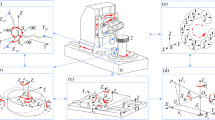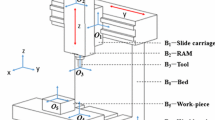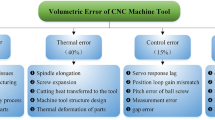Abstract
The ongoing research is hard to predict the machining accuracy of machine tools in the preliminary design phase. Hence, a rapid and quantitative prediction method seems very necessary and imperative. In this study, a new machining accuracy prediction strategy for a five-axis machine tool (FAMT) based on tolerance is proposed. Firstly, a characterization model of surface error profiles for key parts of the FAMT is established, and GESP prediction models based on tolerance for a translational axis and a rotary axis are established by utilizing the mapping relationship between tolerance, surface error profiles, and GESPs of key parts for the FAMT. Then, the kinematic equation of the FAMT is established based on GESPs by using the multi-body system (MBS) theory. As a basis, the actual machining position for the cone frustum based on GESPs by considering the tool setting position and the relative NC machining instruction are solved. And, a machining accuracy prediction model for the cone frustum based on tolerance is established. To enhance the prediction efficiency and intuitively evaluate the machining performance of the FAMT, some accuracy indexes of the cone frustum, such as roundness, angularity, and concentricity, are described. Thus, the machining accuracy prediction model based on key parts’ tolerance parameters of the FAMT is established substantially. Finally, a simulation prediction scheme is conducted. Simulation results show that predicted machining accuracy can meet the requirements of accuracy. To further demonstrate the practicability of the method, experimental verification is implemented. Experimental results show measuring values are very close to predictive ones. Therefore, a reasonable conclusion can be drawn that the proposed method can quickly and effectively predict the machining accuracy of machine tools based on tolerance.































Similar content being viewed by others
References
Yang J, Altintas Y (2013) Generalized kinematics of five-axis serial machines with non-singular tool path generation. Int J Mach Tools Manuf 75:119–132
Zhou Y, Chen ZC, Yang X (2015) An accurate, efficient envelope approach to modeling the geometric deviation of the machined surface for a specific five-axis CNC machine tool. Int J Mach Tools Manuf 95:67–77
Fu G, Fu J, Xu Y, Chen Z, Lai J (2015) Accuracy enhancement of five-axis machine tool based on differential motion matrix: geometric error modeling, identification and compensation. Int J Mach Tools Manuf 89:170–181
Cui G, Lu Y, Li J, Gao D, Yao Y (2012) Geometric error compensation software system for CNC machine tools based on NC program reconstructing. Int J Adv Manuf Technol 63:169–180
Wu C, Fan J, Wang Q, Chen D (2018) Machining accuracy improvement of non-orthogonal five-axis machine tools by a new iterative compensation methodology based on the relative motion constraint equation. Int J Mach Tools Manuf 124:80–98
Cheng Q, Zhao H, Liu Z, Zhang C, Gu P (2016) Robust geometric accuracy allocation of machine tools to minimize manufacturing costs and quality loss. Proc Inst Mech Eng C J Mech Eng Sci 230:2728–2744
Kim K, Kim MK (1991) Volumetric accuracy analysis based on generalized geometric error model in multi-axis machine tools. Mech Mach Theory 26:207–219
Khan AW, Wuyi C (2010) Systematic geometric error modeling for workspace volumetric calibration of a 5-axis turbine blade grinding machine. Chin J Aeronaut 23:604–615
Ding G, Zhu S, Yahya E, Jiang L, Ma S, Yan K (2014) Prediction of machining accuracy based on a geometric error model in five-axis peripheral milling process. Proc Inst Mech Eng B J Eng Manuf 228:1226–1236
Rahman MM, Mayer JRR (2015) Five axis machine tool volumetric error prediction through an indirect estimation of intra- and inter-axis error parameters by probing facets on a scale enriched uncalibrated indigenous artefact. Precis Eng 40:94–105
Liu X, Zhang X, Fang F, Liu S (2016) Identification and compensation of main machining errors on surface form accuracy in ultra-precision diamond turning. Int J Mach Tools Manuf 105:45–57
Wu C, Fan J, Wang Q, Pan R, Tang Y, Li Z (2018) Prediction and compensation of geometric error for translational axes in multi-axis machine tools. Int J Adv Manuf Technol 95(9–12):3413–3435
Dantan J, Bruyere J, Vincent J, Bigot R (2008) Vectorial tolerance allocation of bevel gear by discrete optimization. Mech Mach Theory 43:1478–1494
Qureshi AJ, Dantan J, Sabri V, Beaucaire P, Gayton N (2012) A statistical tolerance analysis approach for over-constrained mechanism based on optimization and Monte Carlo simulation. Comput Aided Des 44:132–142
Wan Din WI, Robinson TT, Armstrong CG, Jackson R (2016) Using CAD parameter sensitivities for stack-up tolerance allocation. Int J Interact Des Manuf 10:139–151
Ghali M, Tlija M, Aifaoui N, Pairel E (2017) A CAD method for tolerance allocation considering manufacturing difficulty based on FMECA tool. Int J Adv Manuf Technol 91:2435–2446
Khim G, Park CH, Shamoto E, Kim SW (2011) Prediction and compensation of motion accuracy in a linear motion bearing table. Precis Eng 35:393–399
Wang Z, Zhao W, Chen Y, Lu B (2013) Prediction of the effect of speed on motion errors in hydrostatic guideways. Int J Mach Tools Manuf 64:78–84
Qi E, Fang Z, Sun T, Chen J, Liu C, Wang J (2016) A method for predicting hydrostatic guide error averaging effects based on three-dimensional profile error. Tribol Int 95:279–289
Zha J, Xue F, Chen Y (2017) Straightness error modeling and compensation for gantry type open hydrostatic guideways in grinding machine. Int J Mach Tools Manuf 112:1–6
He G, Sun G, Zhang H, Huang C, Zhang D (2017) Hierarchical error model to estimate motion error of linear motion bearing table. Int J Adv Manuf Technol 93:1915–1927
Khim G, Oh JS, Park CH (2014) Analysis of 5-DOF motion errors influenced by the guide rails of an aerostatic linear motion stage. Int J Precis Eng Manuf 15:283–290
Tang H, Duan J, Zhao Q (2017) A systematic approach on analyzing the relationship between straightness & angular errors and guideway surface in precise linear stage. Int J Mach Tools Manuf 120:12–19
Lu X, Jamalian A (2011) A new method for characterizing axis of rotation radial error motion: part 1. Two-dimensional radial error motion theory. Precis Eng 35:73–94
Nojehdeh MV, Arezoo B (2016) Functional accuracy investigation of work-holding rotary axes in five-axis CNC machine tools. Int J Mach Tools Manuf 111:17–30
NAS 979 (1969) Uniform cutting test – NAS series. Metal cutting equipments
Uddin MS, Ibaraki S, Matsubara A, Matsushita T (2009) Prediction and compensation of machining geometric errors of five-axis machining centers with kinematic errors. Precis Eng 33:194–201
Ibaraki S, Knapp W (2012) Indirect measurement of volumetric accuracy for three-axis and five-axis machine tools: a review. Int J Autom Technol 6:110–124
ISO 230–1: 2012 (2012) Test code for machine tools—part 1: geometric accuracy of machines operating under no-load or quasi-static conditions
ISO 230-7: 2015 (2015) Test code for machine tools—part 7: geometric accuracy of axes of rotation
Ekinci TO, Mayer JRR (2007) Relationships between straightness and angular kinematic errors in machines. Int J Mach Tools Manuf 47(12–13):1997–2004
Fan J, Tao H, Wu C, Pan R, Tang Y, Li Z (2018) Kinematic errors prediction for multi-axis machine tools’ guideways based on tolerance. Int J Adv Manuf Technol 98(5–8):1131–1144
Sarina S, Zhang JX (2013) Transmission system accuracy optimum allocation for multi-axis machine tools’ scheme design. Proc Inst Mech Eng C J Mech Eng Sci 227(12):2762–2779
Bringmann B, Besuchet J, Rohr L (2008) Systematic evaluation of calibration methods. CIRP Ann Manuf Techn 57(1):529–532
Xiang S, Altintas Y (2016) Modeling and compensation of volumetric errors for five-axis machine tools. Int J Mach Tools Manuf 101:65–78
Li Z, Fan K, Yang J, Zhang Y (2014) Time-varying positioning error modeling and compensation for ball screw systems based on simulation and experimental analysis. Int J Adv Manuf Technol 73(5–8):773–782
ISO 3408-1:2006 (2006) Ball screws - Part 1: Vocabulary and designation
American National Standards Institute (2010) Axes of Rotation: Methods for Specifying and Testing, American Society of Mechanical Engineers
Fan J, Guan J, Wang W, Luo Q, Zhang X, Wang L (2002) A universal modeling method for enhancement the volumetric accuracy of CNC machine tools. J Mater Process Technol 129(1–3):624–628
Lee K, Yang S (2013) Measurement and verification of position-independent geometric errors of a five-axis machine tool using a double ball-bar. Int J Mach Tools Manuf 70:45–52
Wang Q, Wu C, Fan J, Xie G, Wang L (2019) A novel causation analysis method of machining defects for five-axis machine tools based on error spatial morphology of S-shaped test piece. Int J Adv Manuf Technol 103(9–12):3529–3556
Chen D, Dong L, Bian Y, Fan J (2015) Prediction and identification of rotary axes error of non-orthogonal five-axis machine tool. Int J Mach Tools Manuf 94:4–87
Funding
This work is financially supported by the Key Science and Technology Research Project of the Henan Province, China (Nos. 202102210086 and 202102210289); the Key Scientific Research Project for Henan Province Higher school of China (No. 18A460036); the National Natural Science Foundation of China (No. 51775010); and the Doctoral Research Fund Project of the Zhengzhou University of Light Industry for Henan Province of China.
Author information
Authors and Affiliations
Corresponding authors
Additional information
Publisher’s note
Springer Nature remains neutral with regard to jurisdictional claims in published maps and institutional affiliations.
Rights and permissions
About this article
Cite this article
Wu, C., Wang, Q., Fan, J. et al. A novel prediction method of machining accuracy for machine tools based on tolerance. Int J Adv Manuf Technol 110, 629–653 (2020). https://doi.org/10.1007/s00170-020-05762-4
Received:
Accepted:
Published:
Issue Date:
DOI: https://doi.org/10.1007/s00170-020-05762-4




